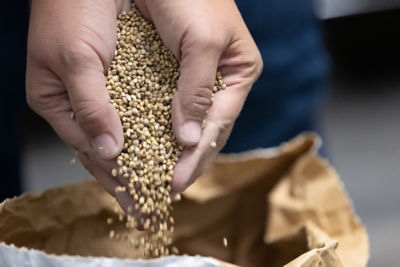Click here to download a PDF version of this spotlight.
» The FRAC code M fungicides have multi-site modes of action against pathogens.
» There is a lower risk of pathogens developing resistance to multi-site fungicides than to single-site fungicides.
» Fungicides in FRAC group M usually have a broad spectrum of activity against different pathogen groups.
The mode of action (MOA) of a fungicide indicates how the fungicide works to help eliminate or inhibit pathogens. From a biological perspective, most fungicides work by inhibiting the germination of fungal spores or inhibiting the growth of fungal hyphae (strands that make up the body of the fungus). The Fungicide Resistance Action Committee (FRAC) classifies fungicides into MOA classes, and it assigns FRAC codes to classes or class subgroups based on the physiological mechanisms by which they affect fungi, including interfering with respiration and energy production, inhibiting nucleic acid and protein synthesis, and inhibiting enzyme functions. A fungicide’s specific MOA determines which pathogens will be affected by that fungicide.1,2
FRAC classifies chemical fungicides that have modes of action with multi-site activity in the M category, and there are twelve groups (M 01 through M 12) in this category.3 Multi-site fungicides are usually broad-spectrum with activity against several different types of fungal and oomycete pathogens. They are protectant fungicides with contact activity. This means that they do not move into plant tissue but remain on plant surfaces where they help prevent rather than eradicate infections. They can be washed off with rain or overhead irrigation. However, sticky formulations or applications with spreader-stickers can provide some protection against washing off. Also, new plant growth is not protected. Therefore, these fungicides usually need to be reapplied more often than systemic products.4,5,6 Not all protectant fungicides are group M fungicides, but all group M fungicides are protectant.
Because they have multi-site modes of action, the M group fungicides are associated with a lower risk of pathogens developing resistance to them and typically have a prolonged life span. These fungicides are routinely used in tank mixes and combination products to help prolong the lifespans of narrow-spectrum, systemic fungicides that are at higher risks for pathogens developing resistance, and to increase the spectra of pathogen effectiveness.4,7
M 01 – Copper-based Fungicides
Copper-based fungicides (FRAC code M 01) are inorganic, elemental fungicides, meaning that their molecular makeup does not include carbon atoms. Copper fungicides affect pathogens by non-specifically denaturing proteins, meaning that the proteins are no longer able to properly function in the pathogen. Copper fungicides can also denature plant proteins, but because they stay on the plant surface, they usually do not damage plant tissue. They can have activity against fungal, bacterial, and oomycete pathogens. There are instances of pathogen populations developing resistance to copper-based fungicides, including the bacterium that causes bacterial spot of pepper and tomato. Several copper salt formulations are used as fungicides, including copper sulfate, copper hydroxide, copper oxychloride, and copper octanoate.3,4,8
M 02 – Sulfur based fungicides
Sulfur based fungicides (FRAC code M 02) are also inorganic, elemental fungicides. Sulfur disrupts the electron transport system in the mitochondria, meaning that the energy production system in the pathogen does not function correctly. Sulfur fungicides inhibit pathogen growth and spore germination. Sulfur is often applied as elemental sulfur dust or wettable sulfur.3,4
M 03 – Dithiocarbamate Fungicides
Dithiocarbamate fungicides (FRAC code M 03) are organic fungicides, meaning that their makeup is based on carbon atoms. This group of fungicides works by inhibiting enzyme activity and affecting amino acids and protein function.1,3 These fungicides usually have a broad-spectrum of activity against various types of plant pathogens. Their activity is similar to chlorothalonil, but they may not be labeled for use on as many crops. Dithiocarbamates include active ingredients such as mancozeb, maneb, thiram, and ziram.3,9
M 05 – Chloronitrile Fungicides
Chloronitrile fungicides (FRAC code M 05) are organic compounds that work by inactivating amino acids and proteins (including enzymes). Chlorothalonil is a chloronitrile fungicide that is applied as a stand-alone or in combination with other active ingredients. Combination products or tank mixes of systemic, single-site fungicides with chlorothalonil are used to help prevent the development of fungicide-resistant pathogens. In over sixty years of use, no cases of pathogen resistance to chlorothalonil have been reported.4,9,10
A few years ago, the U.S. Environmental Protection Agency (EPA) initiated a review of chlorothalonil. As a result of that review, the EPA has proposed changes to regulations on the use of the fungicide on vegetable crops to address concerns related to food and environmental safety issues. The goal is to reduce the level of chlorothalonil residues on food crops and to limit the amount of the fungicide moving into groundwater and aquatic environments. The new regulations also include changes in the use of personal protective equipment (PPE), including the use of gloves and respirators, to help better protect agricultural workers.10,11
SOURCES
1 Matheron, M. 2001. Modes of action for plant disease management chemistries. University of Arizona Cooperative Extension. https://cales.arizona.edu/crop/diseases/papers/dischemistry.html.
2 McGrath, M.T. 2004. What are fungicides? The Plant Health Instructor. DOI: 10.1094/ PHI-I-2004-0825-01. Updated 2016.
3 FRAC Code List© 2024. Fungicide Resistance Action Committee. https://www.frac.info/.
4 Wyenandt, A. 2024. Understanding protectant fungicides (FRAC groups M01 - M11) in 2024. Plant & Pest Advisory. Rutgers Cooperative Extension. May 12, 2024.
5 Schilder, A. 2010. Fungicide properties and weather conditions. Crop Advisory Team Alerts. Michigan State University Extension. https://www.canr.msu.edu/news/fungicide_properties_and_weather_conditions.
6 Mueller, D., Wise, K., Dufault, N., Bradley, C., and Chilvers, M. (Eds.) 2013. Fungicides for field crops. The American Phytopathological Society.
7 FRAC. Importance of multisite fungicides in managing pathogen resistance. https://www.frac.info/fungicide-resistance-management/by-frac-mode-of action-group.
8 McGrath, M. 2020. Copper fungicides for organic and conventional disease management in vegetables. Cornell Vegetables. Cornel University. https://www.vegetables.cornell.edu/pest-management/disease-factsheets/copper-fungicidesfor-organic-disease-management-in-vegetables/.
9 Phillips, B. and Hausbeck, M. 2019. Broad-spectrum fungicides for vegetables. Michigan State University Extension. https://www.canr.msu.edu/news/broad_spectrum_fungicides_for_vegetables.
10 Egel, D. 2024. EPA chlorothalonil review. Vegetable Crops Hotline. Purdue University. Article 730. https://vegcropshotline.org/article/epa-chlorothalonil-review/.
11 EPA. 2023. Chlorothalonil proposed interim registration review decision case number 0097. Docket Number EPA-HQ-OPP-2011-0840. https://www.regulations.gov/document/EPA-HQ-OPP-2011-0840-0141.
Websites verified 5/14/2024
ADDITIONAL INFORMATION
For additional agronomic information, please contact your local seed representative. Performance may vary, from location to location and from year to year, as local growing, soil and environmental conditions may vary. Growers should evaluate data from multiple locations and years whenever possible and should consider the impacts of these conditions on their growing environment. The recommendations in this article are based upon information obtained from the cited sources and should bSe used as a quick reference for information about vegetable production. The content of this article should not be substituted for the professional opinion of a producer, grower, agronomist, pathologist and similar professional dealing with vegetable crops.
BAYER GROUP DOES NOT WARRANT THE ACCURACY OF ANY INFORMATION OR TECHNICAL ADVICE PROVIDED HEREIN AND DISCLAIMS ALL LIABILITY FOR ANY CLAIM INVOLVING SUCH INFORMATION OR ADVICE.
5026_408300 Published 05/31/2024




